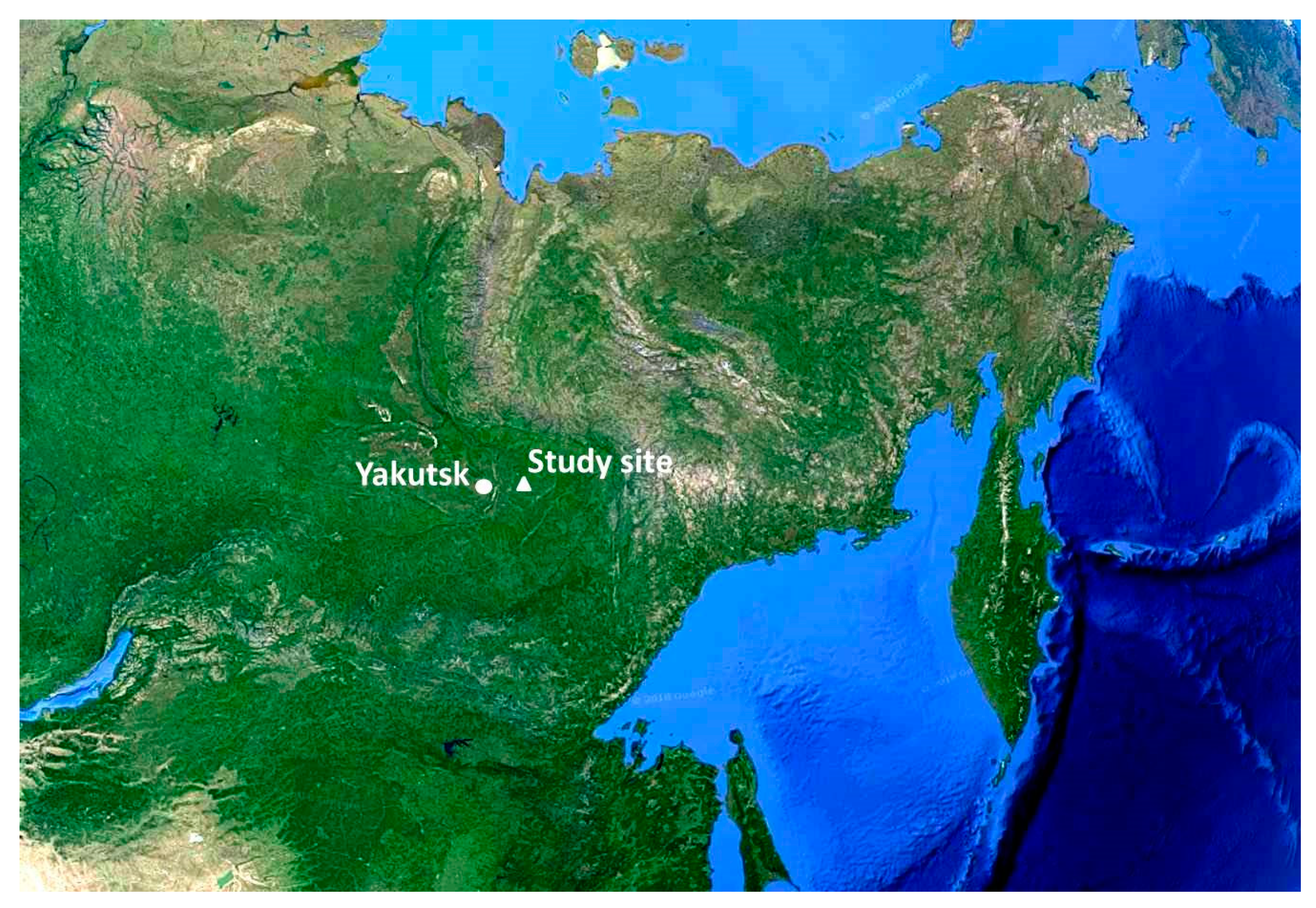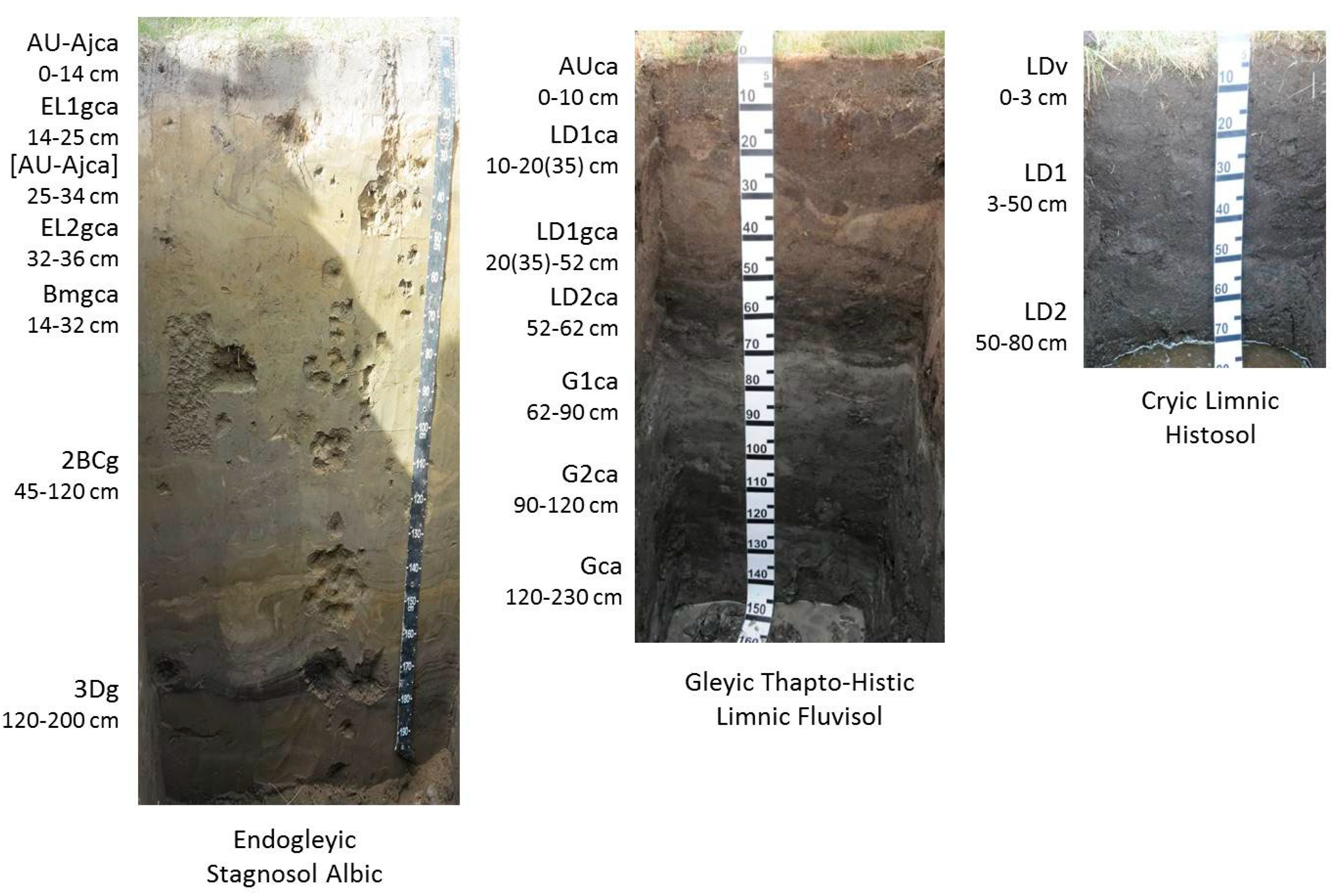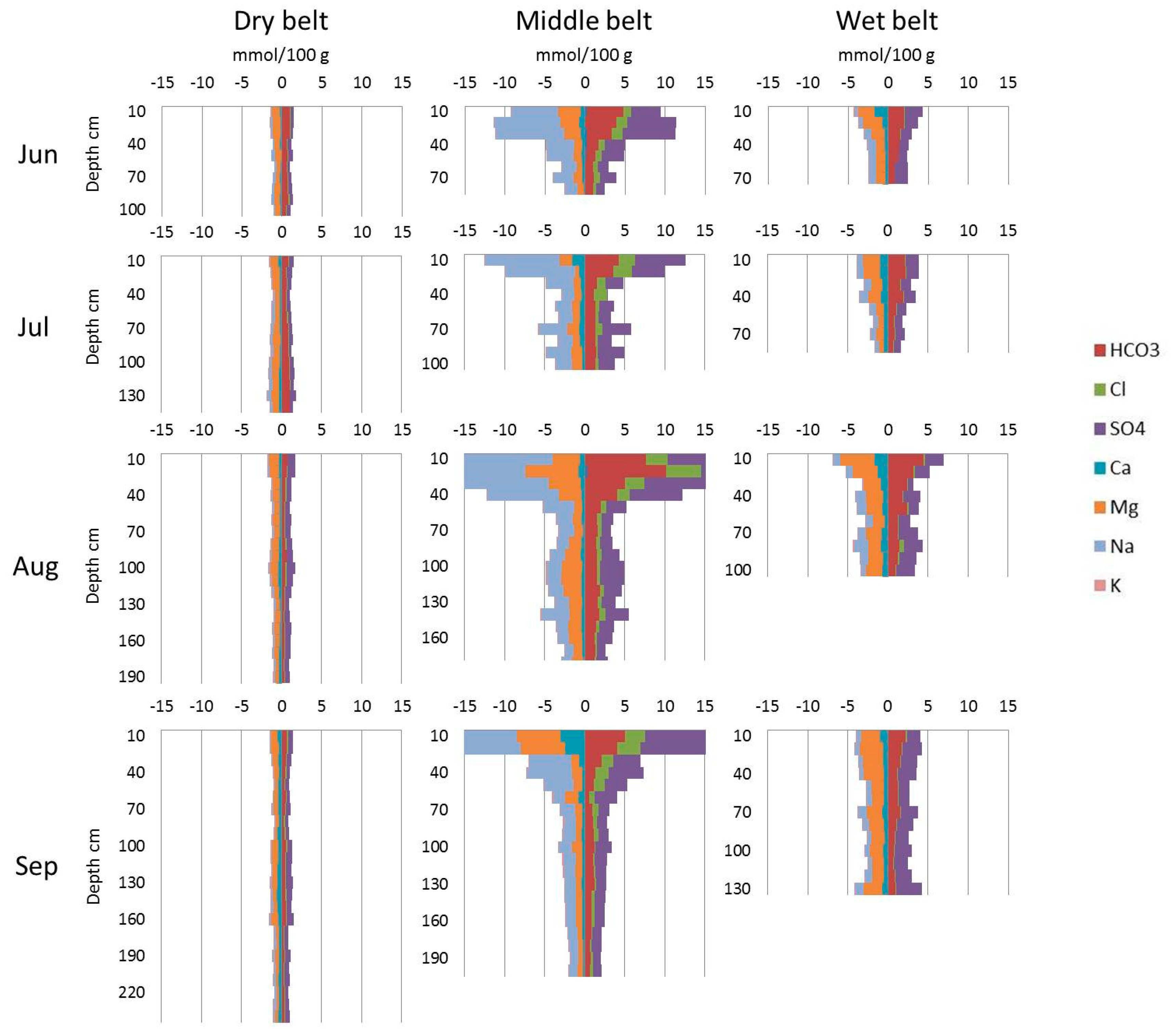Landscape Microzones within Thermokarst Depressions of Central Yakutia under Present Climatic Conditions
Abstract
:1. Introduction
2. Materials and Methods
2.1. Study Site
2.2. Sampling and Analysis
3. Results
4. Discussion
5. Conclusions
Author Contributions
Funding
Conflicts of Interest
References
- Kudrjavtsev, V.A.; Kondratjeva, K.A.; Romanovskii, N.N. The zonal and regional laws of formation of cryolithozone in the USSR. In Works of Ш International Conference on Permafrost Studies; CINII: Osaka, Japan, 1978; pp. 419–426. [Google Scholar]
- Brown, J.; Garve, N.A. The Disturbance of Surface and Its Protection at Development of the North; Nauka: Novosibirsk, Russia, 1981; p. 88. (In Russian) [Google Scholar]
- Bosikov, N.P. Alas Evolution in Central Yakutia; Permafrost Institute, Siberian Division, Russian Academy of Science: Yakutsk, Russia, 1991; p. 128. (In Russian) [Google Scholar]
- Desyatkin, R.V. Content and composition of humus in Lena-Amga interfluve’s Alas soils. In Vesti. Leningrad Univ; No. 6; LSU Press: Leningrad, Russia, 1981; pp. 75–82. (In Russian) [Google Scholar]
- Desyatkin, R.V. Soils of Lena-Amga Interfluve Alases; YF SD SAS Press: Yakutsk, Russia, 1984; p. 168. (In Russian) [Google Scholar]
- Desyatkin, R.V. Soil Formation in Thermokarst Depression—Alases of Cryolithozone; Nauka: Novosibirsk, Russia, 2008; p. 324. (In Russian) [Google Scholar]
- Matsuura, Y.; Ohta, S.; Sanada, M.; Desyatkin, R.V. Carbon and nitrogen storage in soil developed on two different toposequences of the Lena River terrain. In Proceedings of the Second Symposium on the Joint Siberian Permafrost Studies between Japan and Russia in 1993, Tsukuba, Japan, 13–14 January 1994; pp. 177–182. [Google Scholar]
- Iwasaki, S.; Desyatkin, A.R.; Filippov, N.V.; Desyatkin, R.V.; Hatano, R. Carbon stock estimation and changes associated with thermokarst activity, forest disturbance, and land use changes in Eastern Siberia. Geoderma Reg. 2018, 14, e00171. [Google Scholar] [CrossRef]
- Desyatkin, A.R.; Iwasaki, S.; Desyatkin, R.V.; Hatano, R. Changes of soil c stock under establishment and abandonment of arable lands in permafrost area, Central Yakutia. Atmosphere 2018, 9, 308. [Google Scholar] [CrossRef]
- Gavriliev, K.A.; Dmitriev, A.I.; Ivanov, K.P. Sapropel resources of Central Yakutia lakes. In Question of Rational Use and Protection of Natural Resources of Cryolithozone Lakes (on Example of Central Yakutia); Publishing house of Yakutsk University: Yakutsk, Russia, 1983; pp. 47–58. (In Russian) [Google Scholar]
- Bakulina, N.T.; Spektor, V.B.; Novikov, N.I.; Kurchatova, A.N.; Spektor, V.V. The cut of ground deposits of Small Chabydalake. In The Materials of International Conference «Lakes of Cold Regions », Part 4; The Yakutsk State University: Yakutsk, Russia, 2000; pp. 29–41. (In Russian) [Google Scholar]
- Desyatkin, A.R.; Takakai, F.; Fedorov, P.P.; Desyatkin, R.V.; Hatano, R. Effect of human activity on carbon balance in meadows in a thermokarst depression in Siberia. Eur. J. For. Res. 2007, 10, 89–96. [Google Scholar]
- Desyatkin, R.V.; Desyatkin, A.R. Thermokarst transformation of soil cover on cryolithozone flat territories. In Symptom of Environmental Change in Siberian Permafrost Region; Hokkaido University Press: Sapporo, Japan, 2006; pp. 213–223. [Google Scholar]
- Oechel, W.; Hastings, S.; Vourlitis, G.; Jenkins, M.; Riechers, G.; Grulke, N. Recent change of arctic tundra ecosystem from a carbon sink to a source. Nature 1993, 361, 520–523. [Google Scholar] [CrossRef]
- Zimov, S.; Zimova, G.; Davidova, S.; Voropaev, Y.; Voropaeva, Z.; Prosiannikova, O.; Semiletova, I.; Prosiannikova, I. Winter biotic activity and production of CO2 in Siberian soils; a factor in the greenhouse effect. J. Geophys. Res. 1993, 98, 5017–5023. [Google Scholar] [CrossRef]
- Goulden, M.L.; Crill, P.M. Automated measurements of CO2 exchange at the moss surface of a black spruce forest. Tree Physiol. 1997, 17, 537–542. [Google Scholar] [CrossRef] [PubMed]
- Melillo, J.M.; Steudler, P.A.; Aber, J.D.; Newkirk, K.; Lux, H.; Bowles, F.P.; Catricala, C.; Magill, A.; Ahrens, T.; Morrisseau, S. Soil warming and carbon-cycle feedbacks to the climate system. Science 2002, 298, 2173–2176. [Google Scholar] [CrossRef] [PubMed]
- Freeman, C.; Fenner, N.; Ostle, N.J.; Kang, H.; Dowrick, D.J.; Reynolds, B.; Lock, M.A.; Sleep, D.; Hughes, S.; Hudson, J. Export of dissolved organic carbon from peatlands under elevated carbon dioxide levels. Nature 2004, 430, 195–198. [Google Scholar] [CrossRef] [PubMed]
- Frey, K.E.; Smith, L.C. Amplified carbon release from vast West Siberian peatlands by 2100. Geophys. Res. Lett. 2005, 32, L09401. [Google Scholar] [CrossRef]
- Trumbore, S.; Chadwick, O.; Amundson, R. Rapid exchange between soil carbon and atmospheric CO2 driven by temperature changes. Science 1996, 272, 393–396. [Google Scholar] [CrossRef]
- Desyatkin, A.R.; Takakai, F.; Hatano, R. Flood effect on CH4 emission from the alas in Central Yakutia, East Siberia. Soil Sci. Plant Nutr. 2014, 60, 242–253. [Google Scholar] [CrossRef]
- Soloviev, P.A. Cryolithozone of Lena-Amga Interfluve Northern Part; Academy of Science of the USSR: Moscow, Russia, 1959; p. 144. (In Russian) [Google Scholar]
- Sheludiakova, V.A.; Karavaev, M.N.; Petrov, A.M. Meadows and pastures of Central Yakutia. In Materials about Nature and Agriculture of Central Yakutia; Academy of Science of the USSR: Moscow, Russia, 1954; pp. 234–274. (In Russian) [Google Scholar]
- Usanova, V.M. To the question of the classification of alas of the Central Yakut Plain. In Materials of the Vegetation of Yakutia; Academy of Science of the USSR: Leningrad, Russia, 1961; pp. 7–20. (In Russian) [Google Scholar]
- Permyakova, A.A. Vegetation of Yakutia Alases. Ph.D. Thesis, Sverdlovsk State University, Sverdlovsk, Russia, 1961. (In Russian). [Google Scholar]
- Elovskaya, L.G. Influence of soil conditions on the chemistry and nutritional value of fodder plants of Yakutia. In Materials of Soil and Agrochemical Researches of Yakutia; Nauka: Moscow, Russia, 1958; pp. 45–115. (In Russian) [Google Scholar]
- Egorov, A.D.; Grigoriev, D.V.; Kurilyk, T.T.; Sazonov, N.N. Trace Elements in Soils and Grassland Plants of Frozen Landscapes of Yakutia; Academy of Science of the USSR: Yakutsk, Russia, 1970; p. 287. (In Russian) [Google Scholar]
- Gavrilova, M.K. Climate in Central Yakutia; Yakutsk Book Press: Yakutsk, Russia, 1973; p. 119. (In Russian) [Google Scholar]
- Arinushkina, E.V. Soil Chemical Analysis Manual; MSU: Moscow, Russia, 1970; p. 487. (In Russian) [Google Scholar]
- Takakai, F.; Desyatkin, A.R.; Lopez, C.M.L.; Fedorov, A.N.; Desyatkin, R.V.; Hatano, R. CH4 and N2O emissions from a forest-alas ecosystem in the permafrost taiga forest region, eastern Siberia, Russia. J. Geophys. Res. Biogeosci. 2008, 113, G02002. [Google Scholar] [CrossRef]
- Takakai, F.; Desyatkin, A.R.; Lopez, C.M.L.; Fedorov, A.N.; Desyatkin, R.V.; Hatano, R. Influence of forest disturbance on CO2, CH4 and N2O fluxes from larch forest soil in the permafrost taiga region of eastern Siberia. Soil Sci. Plant Nutr. 2008, 54, 938–949. [Google Scholar] [CrossRef]
- Desyatkin, A.R.; Takakai, F.; Fedorov, P.P.; Nikolaeva, M.C.; Desyatkin, R.V.; Hatano, R. CH4 emission from different stages of thermokarst formation in Central Yakutia, East Siberia. Soil Sci. Plant Nutr. 2009, 55, 558–570. [Google Scholar] [CrossRef]
- Desyatkin, R.V. Syngenetic soil salinization during thermokarst Alas formation. Eur. Soil Sci. 1993, 25, 38–46. [Google Scholar]
- Desyatkin, R.V. Soil formation in alases. Soviet Soil Sci. 1991, 23, 9–19. [Google Scholar]
- Nikolaeva, M.C.; Desyatkin, R.V. Dynamics of diversity and productivity of alas dry meadows in Central Yakutia. Restitelnye Resurs. 2016, 52, 20–27. (In Russian) [Google Scholar]
- Morishita, T.; Hatano, R.; Desyatkin, R.V. CH4 flux in an Alas ecosystem formed by forest disturbance near Yakutsk, eastern Siberia, Russia. Soil Sci. Plant Nutr. 2003, 49, 369–377. [Google Scholar] [CrossRef]
- Nikolaeva, M.C.; Desyatkin, R.V. Dynamics of diversity and productivity of alas real meadows in Central Yakutia. Restitelnye Resurs. 2016, 51, 328–335. (In Russian) [Google Scholar]
- Nikolaeva, M.C.; Desyatkin, R.V. Dynamics of diversity and productivity of alas wet meadows in Central Yakutia. Restitelnye Resurs. 2016, 51, 70–80. (In Russian) [Google Scholar]





| Horizon | Depth (cm) | pH | Bulk Density (g/cm3) | Sand (%) | Silt (%) | Clay (%) | C Content (%) |
|---|---|---|---|---|---|---|---|
| Dry belt | |||||||
| AU-Ajca | 0–14 | 8.45 | 1.18 | 74.31 | 22.61 | 3.08 | 2.19 |
| EL1gca | 14–25 | 9.60 | 1.55 | 89.86 | 7.80 | 2.34 | 0.70 |
| (AU-Ajca) | 25–34 | 9.85 | 1.54 | 77.52 | 12.90 | 9.58 | 1.39 |
| EL2gca | 32–36 | 9.85 | – | 63.46 | 29.00 | 7.54 | 1.22 |
| Bmgca | 14–32 | 9.70 | 1.55 | 86.70 | 10.04 | 3.26 | 0.75 |
| 2BCg | 45–120 | 9.25 | – | 34.20 | 51.80 | 14.00 | 1.01 |
| 3Dg | 120–200 | 8.55 | – | 29.69 | 57.19 | 13.12 | 1.06 |
| Middle belt | |||||||
| AUca | 0–10 | 9.95 | 0.81 | 43.5 | 47.84 | 8.66 | 14.24 |
| LD1ca | 10–20(35) | 9.25 | 0.68 | – | – | – | 39.64 |
| LD1gca | 20(35)–52 | 9.15 | 1.04 | – | – | – | 9.73 |
| LD2ca | 52–62 | 9.00 | 0.91 | – | – | – | 7.61 |
| G1ca | 62–90 | 9.25 | 1.59 | 37.73 | 52.05 | 10.22 | 1.23 |
| G2ca | 90–120 | 9.10 | 1.43 | 11.48 | 72.78 | 15.74 | 2.38 |
| Gca | 120–230 | 9.25 | – | 65.39 | 28.57 | 6.04 | 1.56 |
| Wet belt | |||||||
| LDv | 0–3 | – | – | – | – | – | 35.69 |
| LD1 | 3–50 | 8.85 | 0.31 | – | – | – | 68.26 |
| LD2 | 50–80 | 9.35 | 0.36 | – | – | – | 41.63 |
© 2018 by the authors. Licensee MDPI, Basel, Switzerland. This article is an open access article distributed under the terms and conditions of the Creative Commons Attribution (CC BY) license (http://creativecommons.org/licenses/by/4.0/).
Share and Cite
Desyatkin, A.; Takakai, F.; Nikolaeva, M. Landscape Microzones within Thermokarst Depressions of Central Yakutia under Present Climatic Conditions. Geosciences 2018, 8, 439. https://doi.org/10.3390/geosciences8120439
Desyatkin A, Takakai F, Nikolaeva M. Landscape Microzones within Thermokarst Depressions of Central Yakutia under Present Climatic Conditions. Geosciences. 2018; 8(12):439. https://doi.org/10.3390/geosciences8120439
Chicago/Turabian StyleDesyatkin, Alexey, Fumiaki Takakai, and Maya Nikolaeva. 2018. "Landscape Microzones within Thermokarst Depressions of Central Yakutia under Present Climatic Conditions" Geosciences 8, no. 12: 439. https://doi.org/10.3390/geosciences8120439
APA StyleDesyatkin, A., Takakai, F., & Nikolaeva, M. (2018). Landscape Microzones within Thermokarst Depressions of Central Yakutia under Present Climatic Conditions. Geosciences, 8(12), 439. https://doi.org/10.3390/geosciences8120439





